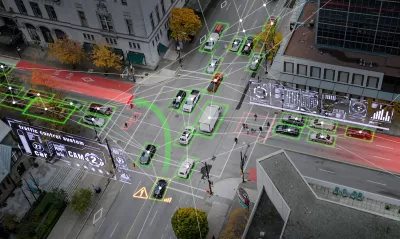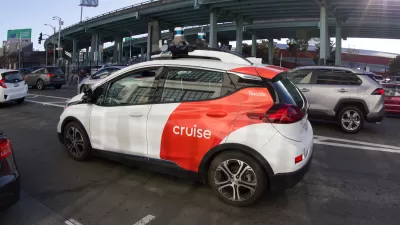How do self-driving cars fit into ‘livable streets?’

An article in Streetsblog USA ponders the future of livable streets as autonomous vehicles start becoming more common on U.S. roads.
As the article explains, “Many sustainable transportation advocates fear that the era of autonomous vehicles will spur us to even further optimize our streets for the efficient operation of machines rather than the cultivation of experiences that make us fully human.” But is it possible to center livability and “make the robo-cars work for us?” the article asks. Streetsblog’s Kea Wilson discusses the issue on The Brake podcast with Dr. Bruce Appleyard, author of Liveable Streets 2.0.
For Appleyard, the worst-case scenario is clear: autonomous cars could lead to more driving, more congestion, and a higher incentive to use vehicles and drive farther. “And what we also see from other studies about autonomous vehicles is that people probably aren't going to pay for the parking of the vehicle, but they're actually gonna continuously cruise,” potentially leading to fleets of self-driving cars creating air pollution and congestion, likely in the most disadvantaged neighborhoods, Appleyard says.
To combat these dangers, Appleyard suggests that “we need to make sure we're very mindful and deliberate in how we go forward to make sure that we maintain both our street livability and our street humanity.” For Appleyard, livability isn’t just about safety and mobility, but “It's how are you being cradled by your environment and encouraged by your environment to, to be at ease, at peace and in a rest restful rejuvenating state.”
FULL STORY: What Do ‘Livable’ Streets Look Like in an Era of Driverless Cars?

Planetizen Federal Action Tracker
A weekly monitor of how Trump’s orders and actions are impacting planners and planning in America.

San Francisco's School District Spent $105M To Build Affordable Housing for Teachers — And That's Just the Beginning
SFUSD joins a growing list of school districts using their land holdings to address housing affordability challenges faced by their own employees.

The Tiny, Adorable $7,000 Car Turning Japan Onto EVs
The single seat Mibot charges from a regular plug as quickly as an iPad, and is about half the price of an average EV.

Seattle's Plan for Adopting Driverless Cars
Equity, safety, accessibility and affordability are front of mind as the city prepares for robotaxis and other autonomous vehicles.

As Trump Phases Out FEMA, Is It Time to Flee the Floodplains?
With less federal funding available for disaster relief efforts, the need to relocate at-risk communities is more urgent than ever.

With Protected Lanes, 460% More People Commute by Bike
For those needing more ammo, more data proving what we already knew is here.
Urban Design for Planners 1: Software Tools
This six-course series explores essential urban design concepts using open source software and equips planners with the tools they need to participate fully in the urban design process.
Planning for Universal Design
Learn the tools for implementing Universal Design in planning regulations.
Smith Gee Studio
City of Charlotte
City of Camden Redevelopment Agency
City of Astoria
Transportation Research & Education Center (TREC) at Portland State University
US High Speed Rail Association
City of Camden Redevelopment Agency
Municipality of Princeton (NJ)





























